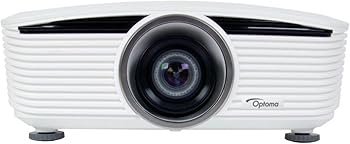When it comes to projectors, the line between professional-grade and consumer products can often feel blurred. Enter the Optoma W505, a projector that claims to bridge that gap with a host of impressive specifications. At 5200 lumens and 1080p resolution, it boasts the kind of brightness and clarity that should make any presentation pop. But here's the kicker: does it really deliver on those promises in the real world, or is it just another piece of tech jargon dressed up to lure in the uninitiated?
With installation flexibility that includes lens shift capabilities and off-axis short throw options, the W505 seems to position itself as a versatile choice for various environments. But with so many features, like advanced image blending tools and full 3D support, one has to wonder—are all these bells and whistles genuinely useful, or are they just complicating what should be a straightforward viewing experience?
In this review, we’ll dive deep into the Optoma W505's performance, practicality, and whether its advanced capabilities truly justify its place in your tech arsenal. Let’s separate the marketing fluff from the real deal.
I’m considering the Optoma W505 projector for a professional setup and would love some insights from those who have experience with it. The specs look impressive, especially the 5200 lumens and 1080p resolution which should provide great picture quality. How does it perform in real-world scenarios? Is the image sharp and vibrant, even in well-lit environments?
I’m also curious about the sound quality; I know projectors usually struggle in this area. Does this one have decent onboard audio, or would I need to invest in external speakers for a better experience?
The installation flexibility sounds promising with features like lens shift and interchangeable lenses. How easy is it to set up? Any potential downsides I should be aware of regarding the system’s compatibility with control systems like CRESTRON or Extron?
Lastly, have any of you experienced any issues with the advanced features like the image blending tools or 3D support? Appreciate any advice you can share!
With installation flexibility that includes lens shift capabilities and off-axis short throw options, the W505 seems to position itself as a versatile choice for various environments. But with so many features, like advanced image blending tools and full 3D support, one has to wonder—are all these bells and whistles genuinely useful, or are they just complicating what should be a straightforward viewing experience?
In this review, we’ll dive deep into the Optoma W505's performance, practicality, and whether its advanced capabilities truly justify its place in your tech arsenal. Let’s separate the marketing fluff from the real deal.
Spec
| Parameter | Optoma W505 Projector |
|---|---|
Picture | |
Reference Price | $1014.98 |
Recommended Uses | Home Cinema, Business |
Built-In Media | Optoma ProScene Projector Model W505 |
Highlight | 5200 Lumens, 1080p resolution Installation flexibility - lens shift, interchangeable lenses, off-axis short Throw option Ultimate control - full support for CRESTRON, Extron, AMX, pj-link and telnet LAN commands Powerful Image blending tools - 3-axis Color matching system and 10x lamp-power Steps Advanced features - wired remote, full 3D support and dicom simulation |
Maximum Resolution | 1920 x 1080 |
Native Resolution | 1280 x 800 |
Brightness | 5200 Lumen |
Display Type | DLP |
Video Encoding | H.264, H.265 |
Controller Type | Remote Control |
Control Method | App, Remote |
Lamp Wattage | 370 Watts |
Wattage | 460 watts |
Connectivity Technology | wired |
Hardware Connectivity | USB, HDMI |
Compatible Devices | Laptop, Gaming Console, Tablet, Smartphone |
Other Features | Throw Lens |
Item Weight | 18.6 Pounds |
I’m also curious about the sound quality; I know projectors usually struggle in this area. Does this one have decent onboard audio, or would I need to invest in external speakers for a better experience?
The installation flexibility sounds promising with features like lens shift and interchangeable lenses. How easy is it to set up? Any potential downsides I should be aware of regarding the system’s compatibility with control systems like CRESTRON or Extron?
Lastly, have any of you experienced any issues with the advanced features like the image blending tools or 3D support? Appreciate any advice you can share!




